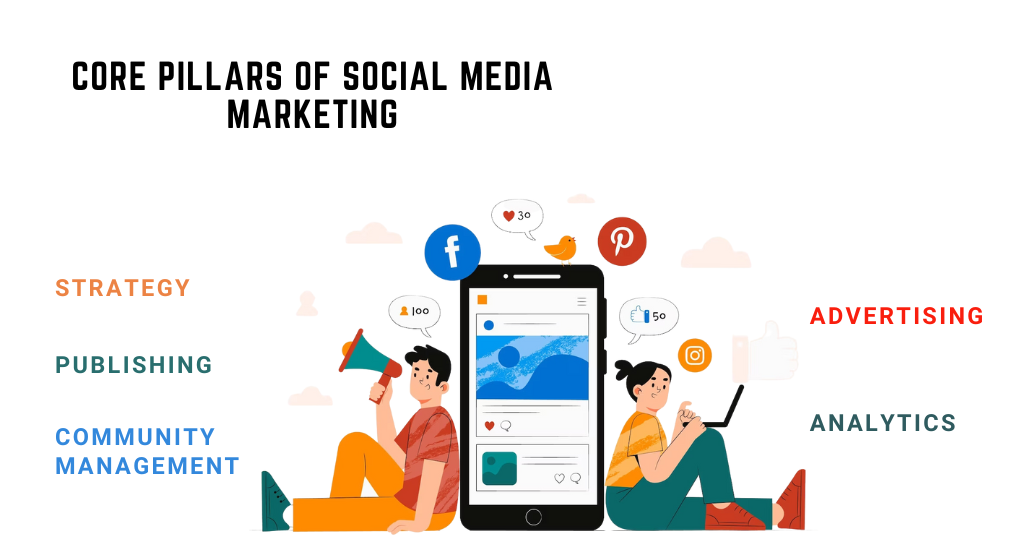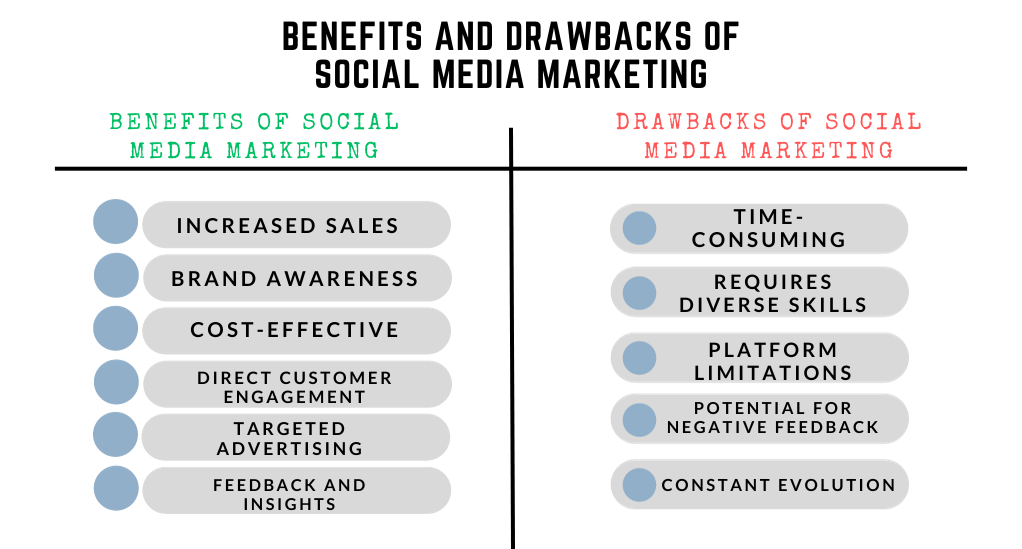
How to Leverage Social Media for Your E-commerce Business
In today’s digital age, the power of social media is undeniable. With billions of users across various platforms, social media has transformed the way businesses communicate, advertise, and sell. For e-commerce businesses, leveraging social media is not just an option—it’s a necessity. Let’s dive into understanding the potential and basics of social media marketing for e-commerce.
The Potential Reach and Cost-effectiveness of Social Media Marketing
When you compare traditional advertising methods like billboards or print ads to social media marketing, the difference in reach and cost is staggering. Consider this: a billboard in a city might cost thousands of dollars a month and be seen by a fraction of the city’s population. On the other hand, a well-crafted post on a platform like Facebook has the potential to reach billions, and organic posts can be published for free.
| Marketing Method | Cost | Potential Reach |
|---|---|---|
| Billboard | High | Local |
| Print Ads | Medium | Local to National |
| Social Media Posts | Low to Free | Global |
While not every post will go viral or reach billions, even a fraction of that audience can be significant for an e-commerce business. Moreover, with the ability to target specific demographics and interests, your return on investment (ROI) with social media marketing can be much higher than traditional methods.
The Basic Definition of Social Media Marketing
At its core, social media marketing is about using platforms like Facebook, Instagram, Twitter, and LinkedIn to promote products or services, build brand awareness, and engage with potential customers. It’s a multifaceted approach that includes:
- Content Creation: Publishing high-quality, relevant content that resonates with your audience.
- Engagement: Interacting with followers, responding to comments, and building a community around your brand.
- Advertising: Using paid promotions to boost your reach and target specific demographics.
- Analysis: Monitoring performance metrics to refine and improve your strategies.
For e-commerce businesses, social media marketing can drive traffic to the website, increase sales, and enhance customer loyalty. It’s a dynamic and ever-evolving field, with new trends, platforms, and strategies emerging regularly. Staying informed and adaptable is key to leveraging its full potential.
Core Pillars of Social Media Marketing
To truly harness the power of social media for your e-commerce business, it’s essential to understand its foundational pillars. These pillars serve as the backbone of any successful social media strategy, ensuring that your efforts are targeted, effective, and yield the desired results.

Strategy: Setting Goals, Target Audiences, and Content Plans
Before diving into the world of posts, likes, and shares, you need a clear strategy. This involves:
- Goal Setting: Are you looking to increase brand awareness, drive traffic to your website, or boost sales? Your goals will shape your content and approach.
- Target Audience Identification: Who are you trying to reach? Understanding your audience’s demographics, interests, and online behaviors will help tailor your content to resonate with them.
- Content Planning: What will you post, and when? A content calendar can help you plan posts in advance, ensuring a consistent and varied content mix.
Publishing: Creating and Scheduling Content
Content is king in the realm of social media. It’s your primary tool for engaging with your audience. Consider:
- Content Types: From blog posts and infographics to videos and quizzes, diversify your content to keep your audience engaged.
- Scheduling: Tools like Buffer or Hootsuite can help you schedule posts for optimal times, ensuring maximum visibility and engagement.
- Consistency: Regular posting keeps your brand at the forefront of your audience’s mind and fosters trust.
Community Management: Engaging with the Audience
Social media is a two-way street. It’s not just about broadcasting; it’s about listening and engaging.
- Responding to Comments: Positive or negative, every comment is an opportunity to engage and showcase your brand’s personality.
- Building Relationships: Engage with other brands, influencers, and potential partners to expand your reach.
- Handling Criticism: Address negative feedback professionally and promptly. It can turn a critic into an advocate.
Advertising: Organic vs. Paid Content
While organic growth is essential, paid advertising can amplify your reach and target specific segments.
- Organic Content: These are your regular posts that reach your existing followers and anyone they might share with.
- Paid Content: Platforms like Facebook and Instagram allow for targeted ads based on demographics, interests, and more. This can help you reach a broader or more specific audience.
Analytics: Monitoring and Analyzing Campaign Performance
What’s working? What’s not? Analytics provide the answers.
- Key Metrics: Track metrics like engagement rate, click-through rate, and conversion to gauge the effectiveness of your posts.
- Refinement: Use insights from analytics to refine your strategy, tweak your content, and optimize for better results.
Benefits and Drawbacks of Social Media Marketing
While the advantages of social media marketing are numerous, it’s essential to be aware of potential pitfalls. By understanding both sides of the coin, e-commerce businesses can make informed decisions and optimize their strategies for success.

Benefits of Social Media Marketing
- Increased Sales: A well-executed social media campaign can drive significant traffic to your e-commerce site, leading to higher conversions and sales.
- Brand Awareness: Social media platforms offer a vast audience. Regular posting and engagement can significantly boost your brand’s visibility and recognition.
- Cost-Effective: Compared to traditional advertising methods, social media marketing can be much more budget-friendly, especially when focusing on organic growth.
- Direct Customer Engagement: Social media allows for real-time interaction with customers, fostering stronger relationships and trust.
- Targeted Advertising: Platforms like Facebook and Instagram offer sophisticated targeting options, ensuring your ads reach the most relevant audience.
- Feedback and Insights: Direct customer feedback and advanced analytics tools provide valuable insights into customer preferences and behavior.
Drawbacks of Social Media Marketing
- Time-Consuming: Crafting quality content, engaging with followers, and monitoring metrics can be time-intensive.
- Requires Diverse Skills: Effective social media marketing requires a mix of skills, including content creation, analytics, and customer engagement.
- Platform Limitations: Each platform has its own set of rules and algorithms, which can sometimes limit reach and engagement.
- Potential for Negative Feedback: Public platforms mean public criticism. Handling negative feedback gracefully is crucial.
- Constant Evolution: The digital landscape changes rapidly. Staying updated with the latest trends, platform updates, and algorithms is essential.
Developing a Successful Social Media Strategy for E-commerce
Crafting a winning strategy requires careful planning, research, and execution. Here’s a step-by-step guide:
1. Set Your Budget and Goals
Determine how much you’re willing to invest in social media marketing, both in terms of money and time. Align your social media goals with your overall business objectives.
2. Identify Your Target Audiences
Understand who you want to reach. Create customer personas based on demographics, interests, and online behaviors.
3. Research Competitors
Analyze what your competitors are doing right (and wrong). This can provide valuable insights and inspiration for your strategy.
4. Choose the Right Platforms
Not all platforms will be suitable for your brand. Focus on where your target audience spends their time.
5. Define Your Social Media Brand
Your online voice and aesthetic should be consistent with your overall brand but tailored to the nuances of each platform.
6. Craft a Content Strategy
Plan your content mix, keeping in mind the 80-20 rule: 80% of your content should inform, educate, or entertain, while 20% can be promotional.
Key Social Media Metrics for E-commerce
To ensure that your social media efforts are yielding the desired results, it’s crucial to monitor specific metrics. These metrics provide insights into the effectiveness of your campaigns and highlight areas for improvement.
1. Reach and Impressions
- Reach: This metric indicates the total number of unique users who have seen your post.
- Impressions: This represents the total number of times your content has been displayed on someone’s screen.
2. Engagement Metrics
- Likes and Reactions: These are immediate indicators of how your audience perceives your content.
- Comments: A higher number of comments usually indicates that your content is sparking conversation.
- Shares and Retweets: This shows how many users found your content share-worthy, amplifying its reach.
3. Click-through Rate (CTR)
This metric represents the percentage of users who clicked on a link in your post compared to the total number of users who viewed the post. A higher CTR often indicates compelling content or effective calls-to-action.
4. Conversion Rate
For e-commerce businesses, this is a crucial metric. It measures the percentage of social media traffic that takes a desired action on your website, such as making a purchase or signing up for a newsletter.
5. Return on Investment (ROI)
This metric helps you determine the profitability of your social media campaigns. It’s calculated by taking the net profit from the campaign and dividing it by the total costs.
6. Follower Growth Rate
Monitor how quickly your audience is growing over time. A steady increase in followers indicates that your brand is gaining traction.
7. Mention and Share of Voice
- Mentions: Track how often your brand is mentioned across social media platforms.
- Share of Voice: This metric compares your brand’s mentions to those of your competitors, giving you an idea of your market presence relative to others.
Advanced Social Media Strategies for E-commerce
To stay ahead in the competitive e-commerce landscape, businesses need to adopt advanced strategies that go beyond basic posting and engagement.
Influencer Collaborations
Partnering with social media influencers can help you tap into their established audiences, enhancing brand visibility and credibility.
User-Generated Content (UGC)
Encourage your customers to share their experiences with your products. UGC acts as social proof and can significantly boost trust and sales.
Social Shopping Features
Platforms like Instagram and Facebook now offer in-app shopping features. Utilize these to provide a seamless shopping experience for your customers.
Chatbots and Customer Service
Integrate AI-driven chatbots to answer queries, provide product recommendations, and even process orders directly through social media platforms.
Video Marketing
With the rising popularity of platforms like TikTok and the introduction of features like Instagram Reels, video content is more crucial than ever. Create engaging, short-form videos to showcase products, share tutorials, or tell your brand’s story.
Transforming Followers into Customers
One of the primary objectives of social media marketing for e-commerce businesses is not just to gain followers, but to convert those followers into loyal customers. Here’s how you can effectively make that transformation:

Exclusive Offers for Social Media Followers
Reward your followers with exclusive deals or discounts available only to those who follow your social media channels. This not only incentivizes purchases but also encourages more users to follow your brand.
Engaging and Interactive Content
Use polls, quizzes, and interactive posts to engage your audience. For instance, run a poll asking which product color they’d like to see next or host a Q&A session about upcoming product launches.
Showcase Customer Testimonials and Reviews
Positive reviews and testimonials can significantly influence purchasing decisions. Share user-generated content, reviews, and testimonials to build trust and credibility.
Behind-the-Scenes Content
Give your followers a sneak peek into the workings of your business. Whether it’s the process of product creation, packing, or a day in the life at your office, such content makes followers feel more connected to your brand.
Seamless Shopping Experience
Integrate shopping features into your social media profiles. Platforms like Instagram allow users to shop directly from posts, making the purchasing process smooth and straightforward.
Personalized Engagement
Engage with your followers on a personal level. Respond to their comments, answer their queries, and acknowledge their feedback. A personal touch can make a significant difference in building brand loyalty.
Loyalty Programs and Contests
Host regular contests or giveaways, encouraging followers to participate by tagging friends, sharing your content, or using a specific hashtag. Additionally, introduce loyalty programs where followers earn points for every engagement or purchase, which they can later redeem.
Common Mistakes to Avoid in Social Media Marketing
While there are numerous strategies to adopt, there are also pitfalls to steer clear of:
Neglecting Negative Feedback
Ignoring or deleting negative comments can harm your brand’s reputation. Address criticisms professionally and try to resolve issues promptly.
Over-Promotion
While it’s essential to promote your products, ensure your content isn’t overly salesy. Followers are looking for value, not constant sales pitches.
Inconsistent Posting
Irregular posting can make your brand appear inactive or disinterested. Maintain a consistent posting schedule to keep your audience engaged.
Not Adapting to Platform Algorithms
Social media platforms frequently update their algorithms. Not staying updated can result in decreased visibility for your posts.
Ignoring Analytics
Not monitoring or acting on insights from analytics can hinder growth. Regularly review metrics to refine your strategies.
Conclusion
In the digital age, social media has emerged as a powerful tool for e-commerce businesses, bridging the gap between brands and their audiences. By leveraging the vast reach and interactive nature of these platforms, businesses can not only amplify their brand presence but also foster deeper connections with their customers. From crafting engaging content and harnessing the power of influencer partnerships to navigating the intricacies of platform algorithms and metrics, the journey of social media marketing is both challenging and rewarding. However, with a strategic approach, continuous learning, and a keen focus on customer-centricity, e-commerce brands can transform their social media channels into significant revenue drivers. As the digital landscape continues to evolve, those who adapt, innovate, and prioritize genuine engagement will undoubtedly thrive in the bustling marketplace of social media.


Leave a Reply